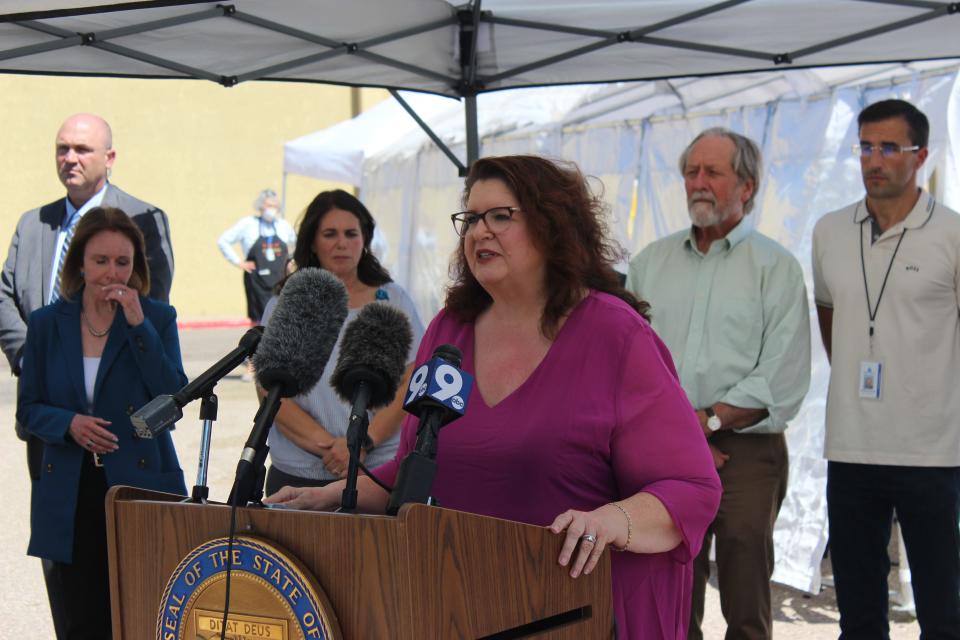Sinema talks to Tucson nonprofits, local leaders about post-Title 42 border situation
- Oops!Something went wrong.Please try again later.
TUCSON — U.S. Sen. Kyrsten Sinema said Tuesday that the federal government must remain vigilant for another uptick in migrant arrivals even as numbers steadily decrease in the weeks after Title 42’s end.
Sinema, I-Ariz., alongside Sen. James Lankford, R-Okla., held a roundtable discussion about the end of Title 42 with humanitarian nonprofits and local leaders at the Pima County Historic Courthouse in Tucson.
The discussion comes nearly two weeks after Title 42 officially lifted on May 11 after more than three years. The pandemic-era border restriction allowed border officials to rapidly turn back migrants arriving at the country’s borders.
“There was indeed a large surge in the days both before and right after the end of Title 42, and while we've seen those numbers decrease, we believe that the surge will come again,” Sinema said. “If we were to pull back attention at the federal level, stop working on legislation, pull back resources, we can guarantee that the next surge will come when we're not prepared for it.”
Sinema: Arizona will 'bear the brunt' of Biden failure to prepare for border surge
The U.S. Border Patrol documented fewer than 3,000 migrant apprehensions per day over the weekend, according to Border Patrol Chief Raul Ortiz. The figures show a steep decline in numbers compared with the roughly 10,000 daily apprehensions seen before Title 42’s expiration.
Sinema continuously has raised concerns about the Biden administration’s preparedness to respond to the lifting of the restriction for months.
Ports of entry along the U.S.-Mexico border, however, were largely quiet and there was no influx of migrants when the restriction was lifted on the night of May 11.
While an immediate influx of people did not materialize, humanitarian nonprofits in Arizona have dealt with an increase in migrants from the days before the restriction went away.
Pima County has logged 11,724 migrant arrivals so far in May, according to numbers provided during the roundtable. The number does not include the 1,248 people whom the county had to transport to Phoenix for shelter support.
Nonprofits, volunteers and local officials came together to help prevent any unsheltered street releases in communities despite coming extremely close to them.
“It was really on the shoulders of a lot of people,” Shane Clark, director of the Pima County Office of Emergency Management, said in regard to the county’s response to the uptick of arrivals.

Casa Alitas was circulating roughly 1,000 people through its facilities per day in the days leading up to and following Title 42’s end. Today, Casa Alitas is serving roughly 500 people per day, according to Teresa Cavendish, Casa Alitas executive director.
Title 42 rhetoric: Ruben Gallego echoes Kyrsten Sinema on border preparedness as Sinema proposes extending restrictions
On May 8, the state established new bus routes for migrants to be transported from small border communities to Tucson and Phoenix. The state effort aims to curb unsheltered migrant street releases in the rural communities that don’t have the infrastructure to house, feed or transport asylum seekers.
From May 8 to May 14, the state transported 3,025 asylum seekers on 87 buses, according to the Arizona Department of Emergency and Military Affairs. The routes initially ran from Nogales, Naco, Douglas and Bisbee to Casa Alitas in Tucson twice a day.
On May 17, DEMA announced that the charter buses leaving southeastern Arizona would be diverted to Phoenix, instead of Tucson, where there is greater capacity to assist people seeking asylum.
In the days following Title 42’s end, a couple hundred asylum seekers began to line up outside of the Dennis DeConcini Port of Entry in Nogales to try to seek asylum without a CBP One appointment. People waited in line for days as they endured the blistering sun and frigid nights, often rationing food and water.
The discussion was part of Sinema’s two-day trip to southern Arizona in the wake of the restriction’s lifting. On Wednesday, Sinema will tour the Dennis DeConcini Port of Entry in Nogales after viewing parts of the border wall.
On May 4, Sinema and Sen. Thom Tillis, R-N.C., introduced legislation that would establish a temporary two-year extension that would allow officials to expel migrants from the U.S. and function similarly to Title 42.
Sinema and Tillis first proposed a last-minute draft framework to extend Title 42 for another year in December when the restriction was expected to lift. The proposed agreement would also have given 2 million undocumented young people, known as "Dreamers," a path to citizenship.
The proposal failed to garner enough support in the Senate before Congress adjourned in December.
In April, Sinema visited parts of Cochise County where she met with local officials and said the U.S. Department of Homeland Security did not have adequate plans in place for the lifting of Title 42.
Sen. Kyrsten Sinema: Homeland Security not ready for end of border restriction
Have a news tip or story idea about the border and its communities? Contact the reporter at josecastaneda@arizonarepublic.com or connect with him on Twitter @joseicastaneda.
This article originally appeared on Arizona Republic: Sinema meets with nonprofits, local leaders after Title 42's end

